Crimson Trace made a name for itself by creating a wide variety of visible laser systems. Their lasers built into various grips made them quite famous and provided a secondary aiming point for shooters. They’ve mastered one red dot type of aiming mechanism and have since moved to a second form of red dot. They’ve more or less burst onto the scene with a wide variety of red dots in various sizes and at various price points. Today we are reviewing the Crimson Trace CTS-1000 Compact Tactical Red Dot sight.
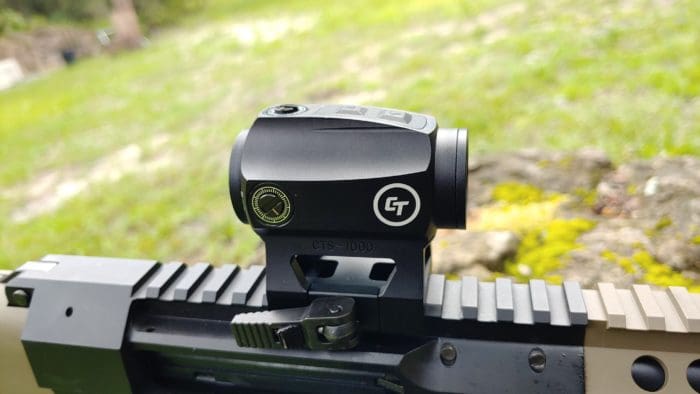
The CTS-1000 is one of two enclosed emitter red dot sights in their line, and this is the ‘premium’ model. It has a much higher MSRP and does come with a more diverse set of features. The MSRP is listed as 339.99; however, they seem to retail for around $150 online. Crimson Trace sent me this optic for test and review.
The Basics
The CTS-1000 comes with a high mount designed for AR-type rifles. It allows absolute co-witness with AR-height iron sights. The mount is an adjustable QD design with an integrated locking system. It came rather loose, and the adjustment wheel tightened it up. The wheel that adjusts the mount is somewhat stuff, and a pair of needle-nose pliers made it move and tighten down.
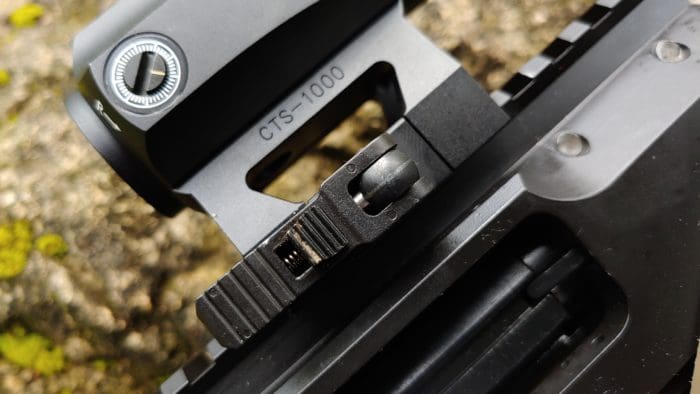
The lock is a simple tab that ensures the QD tab won’t get caught on your gear and accidentally become undone. A nice touch for a QD mount. The Crimson Trace box is quite nice and comes padded with a lens cloth, Torx wrench, battery, and little lens cloth. A 2 MOA dot occupies the lens, and it appears only red dots are currently available from Crimson Trace.
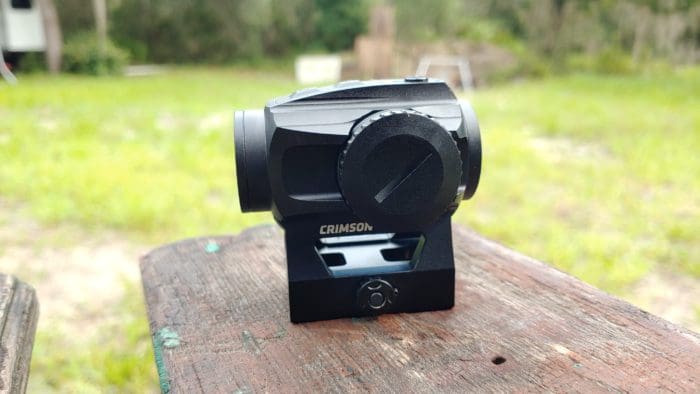
Overall, it’s not crazy or revolutionary, but it doesn’t have to be either. It’s a simple red dot tagged with a relatively decent price point. The real question was, how does it perform? It’s a crowded market with optics from Holosun, SIG, Vortex, and more occupying the budget space and occupying it well. It’s the best time in the world to be shopping for a budget-friendly red dot optic.
Does the CTS-1000 deserve its place with all these other budget optics?
Through the Window
The 2 MOA red dot is nice and crisp, surprisingly so. I remember when a budget red ‘dot’ resulted in more of a budget red squiggly mark. Emitter technology must have improved and gotten cheaper along the way. The CTS-1000 provides a very capable little dot backed by ten brightness settings that get absurdly bright.
Here in the sunshine state of Florida, we challenge brightness levels between the hours of 12 and 3 PM. The CTS-1000 doesn’t seem to mind. It can get absurdly bright and doesn’t struggle at all in the bright light of Florida. The notch coating certainly helps here, and as I understand, these coatings work like other red dot coatings but are more effective for showing a dot’s brightness. This allows a dot to use less battery power while appearing brighter.

There is a very slight blue tint, super light, and I honestly question if it’s there or if I want it to be there. It’s tough to tell, and that’s fine with me. I like the bright and clear view through the optic, but there are some downsides.
The CTS-1000 is very busy when you look through the lens. The optic around the window is seemingly very large, with the battery compartment being massive and the sides of the optics sticking right in your view. Inside the optic, you can see the emitter sticking up just a hair as well. Compared to optics like the SIG ROMEO5, it seems very busy and crowded.
At the Range
At the range, what’s the best way to test a red dot? Why not a semi-auto shotgun? I’ve been reviewing the SRM 1216, and tossing the CTS-1000 on it seemed like a great idea. Can it take a ton of abuse? Will the recoil force it to lose zero? Well, only one way to find out.

I zeroed the optic using basic buckshot, and the big 1 MOA adjustments make zeroing pretty easy. 1 MOA is the absolute largest adjustment I want on a red dot. For a rifle, I might prefer a .5 MOA adjustment, but I can deal with the 1 MOA adjustment. The turrets of the CTS-1000 provide amazing feedback and are super nice. They click positively and are very tactile and audible. They are better than much more expensive optics like the Vortex SPARC Solar.
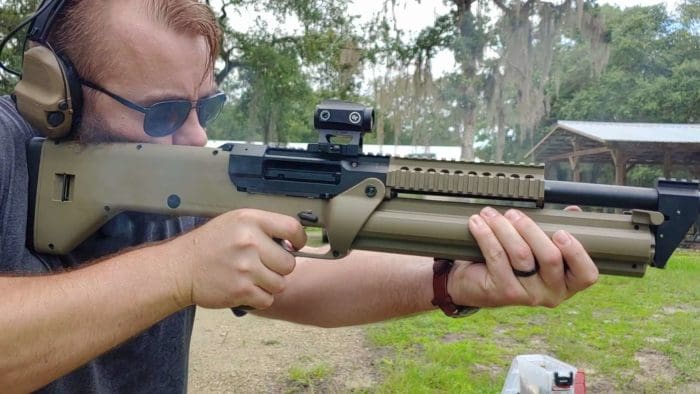
After I was on target, I let the lead fly! I fired a mix of buckshot and birdshot at various targets. One of my favorite drills using birdshot with the SRM1216 is to toss four clay pigeons on the berm and trying to take out all four as fast as possible. The 1216 uses four rotating tubes, so I load each tube with one round and rotate between tubes after every shot.
With the CTS-1000, I had no problems jumping from one clay pigeon to the other in their randomized locations. The easy-to-see dot makes transitions quick, and I’d often be on target before I fully rotated the tube. While the view is crowded, I never had an issue seeing the next clay pigeon between shots.

Twelve gauge recoil also never pushed the optic hard and caused it to fail or lose zero. I backed off to 50 yards and pegged a steel target with slugs over and over. Still, it never blinked or fluttered between shots.
Durability
Sure, recoil is one thing, but what about overall durability? If I could, I’d give it a private in a line company and let him see how long it took to break. I can’t, but I can toss it on an ASP red gun and beat the hell out of it. I marked where it sat on the SRM 1216 to help retain zero and tossed it on the red gun.
I began to test durability a bit. This includes throwing it, dropping it, slamming it against the ground a few times. I dropped it from shoulder height at all angles, haphazardly tossed it, and slammed it into a punching bag.

A look through the CTS-1000 revealed the dot was still on and didn’t stutter or fail at all. Since it was dirty, I fired up the outdoor faucet and hit it with a blast of water. Submerging it is one thing, but hitting with a jet of water is completely different. I shoulder the red dot and found the dot right where I expected it.
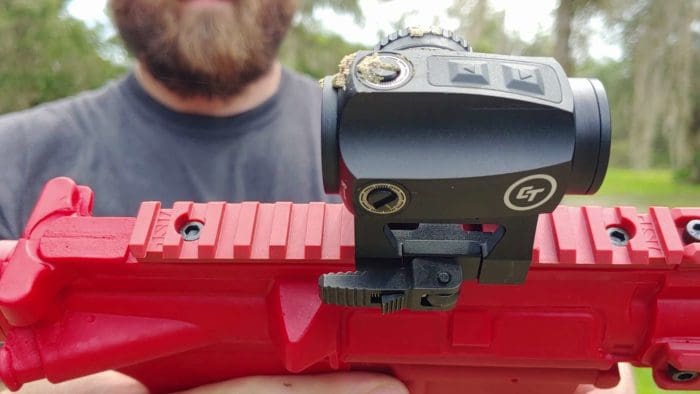
I reinstalled the optic onto the SRM 1216, loaded up some buckshot, and got frisky with the gun once more. I used slugs because they are a better of a zero judge than shot and walked it back to 25 yards, then 50 yards. I didn’t lose any zero through tossing a little abuse at the CTS-1000.

Overall, this little budget-worthy red dot optic surprised me. It’s well made, affordable, and provides a bright and easy-to-see red dot reticle. It’s simple, and simple is perfectly fine with optics like these. Oh, and like other Crimson Trace products, you get free batteries for life.
Specifications: Crimson Trace CTS-1000 Red Dot Sight
Reticle: 2 MOA Red Dot
Brightness Settings: 10
Battery Type: CR2032
Battery Life: Up to 9 Years
Height: 2.5 inches
Length: 2.7 inches
Width: 2.1 inches
Weight: 5.9 ounces
Price: MSRP $339.99 (Street Price about $155)
Ratings (out of five stars):
Ergonomics * * * * *
The red dot is super lightweight, small, and packs an awesome QD mount for quick attachment and removal when necessary. Adjust buttons sit on top of the optic and make it easy to adjust the optic on the fly.
Clarity * * * *
The lenses and dot are clear and crisp. They appear very nice and are very easy to see. The downside is the crowded look the optic has, which reduces some peripheral vision. It’s not a major issue, but worth noting.
Overall * * * *
The CTS-1000 is a well-made optic at a great price point. It’s light, easy to use, and dang sure durable for its price point. The CTS-1000 certainly earns its place with many of the optics in the budget red dot role.

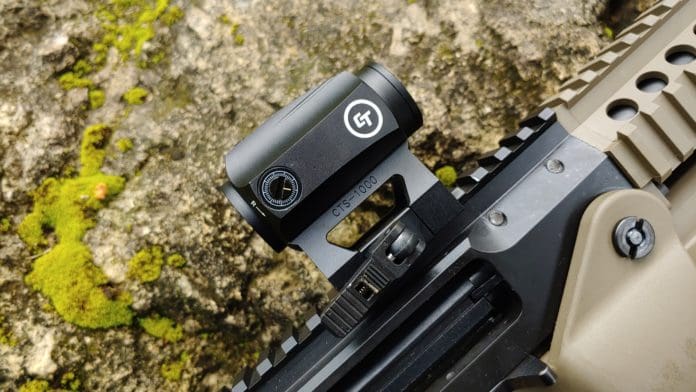



What is the COUNTRY OF ORIGIN?
China…
How can someone be excited over new gunms or gunm products when Our constitutional right to bear arms is being stripped from us?
$340?
Are you smoking crack? It’s a fucking crimson trace and you say that’s a good price point for it? Literally 5 different options $140 cheaper that are 10x better.
You must have missed the two points in the article where it said “they seem to retail for around $150 online” and “Street Price about $155.”
putting it on ak good idea?
Awesome article! I really like it and I will recommend it to my friends
Comments are closed.